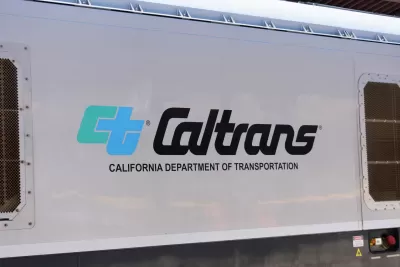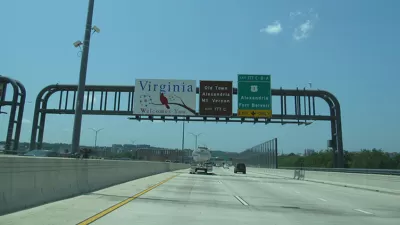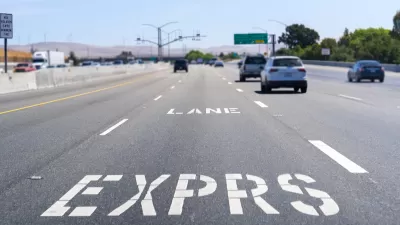The California Department of Transportation released its draft carbon reduction strategy last month to apply for Carbon Reduction Program funds included in the Infrastructure Investment and Jobs Act. Road pricing plays a prominent role.

On April 21, 2022, the Federal Highway Administration (FHWA)'s Office of Planning, Environment, and Realty released a 16-page ‘implementation guidance’ [pdf] document for one of the climate programs included in the Infrastructure Investment and Jobs Act administered by FHWA.
The purpose of the Carbon Reduction Program (CRP) is to reduce transportation emissions through the development of State carbon reduction strategies and by funding projects designed to reduce transportation emissions.
Related in Planetizen on the CRP:
- Planetizen (expired) event: Experts unpack the $6 billion Carbon Reduction formula program, Jan. 18, 2023
- Planetizen news: Feds Release $60 Billion for Roads, Bridges, and Carbon Reduction, October 12, 2022
And on reducing transportation emissions on the federal level:
- Federal Plan Takes Aim at Transportation Emissions, January 10, 2023
- Proposed Rule Would Require Emission Reductions From U.S. Highway System, September 7, 2022
California's application
The program provides roughly $1.25B to $1.33 billion per fiscal year for five years. California's department of transportation, Caltrans, in partnership with the state’s metropolitan planning organizations (MPOs), developed a draft Carbon Reduction Strategy (CRS), the source article [pdf] for this post, to submit to the Federal Highway Administration for approval by November 2023, according to an older Caltrans webpage.
California's CRS focuses on the “Three Pillars:” zero-emission vehicles (ZEVs) and infrastructure, active transportation, and rail and transit. All CRP funds must be spent in support of the Three Pillars, according to the updated Caltrans CRP webpage.
Not by ZEVs alone
“Although transitioning to electric and hydrogen vehicle technologies is critical to carbon reduction, the CARB Scoping Plan is clear that California cannot achieve carbon neutrality with ZEVs alone,” states the strategy on pg. 4 under the sub-heading, Reducing Transportation’s Carbon Emissions.
Related:
- New Scoping Plan Sets Carbon Neutrality Goal for California, November 21, 2022
- Electric Vehicles Alone Will Not Reduce Emissions to Meet California's Climate Goal, November 29, 2018
Even with California’s mandate that all new car sales be ZEVs beginning in 2035, many vehicles will still have traditional internal combustion engines. To achieve carbon neutrality, Californians need to drive less: 25 percent below 2019 levels by 2030 and 30 percent below 2019 levels by 2045.
Vehicle Miles Traveled (VMT) reduction
The last page of the 19-page report,describes a fourth carbon reduction strategy: Roadway Pricing.
California will use its State CRP funding on projects that convert existing highway lanes into priced managed lanes. Roadway pricing--including Express and High Occupancy Toll (HOT) lanes, congestion pricing, and toll roads and bridges- -are critical to achieving carbon neutrality by 2045. The CARB Scoping Plan estimates that between 27% and 37% of the VMT reduction needed to reach carbon neutrality will come from roadway pricing
“California’s State CRP funds will be programmed through the State Highway Operations and Protection Program (SHOPP) on projects that convert existing lanes to priced managed lanes,” according to Caltrans. What's not clear, though, is what type of “existing lanes” Caltrans is referring to – general purpose or High Occupancy Vehicle lanes.
Hat tip to Steve Birdlebough, Sierra Club California Transportation and Sustainable Communities committee.
FULL STORY: California Transportation Carbon Reduction Strategy [pdf]

Planetizen Federal Action Tracker
A weekly monitor of how Trump’s orders and actions are impacting planners and planning in America.

Congressman Proposes Bill to Rename DC Metro “Trump Train”
The Make Autorail Great Again Act would withhold federal funding to the system until the Washington Metropolitan Area Transit Authority (WMATA), rebrands as the Washington Metropolitan Authority for Greater Access (WMAGA).

The Simple Legislative Tool Transforming Vacant Downtowns
In California, Michigan and Georgia, an easy win is bringing dollars — and delight — back to city centers.

The States Losing Rural Delivery Rooms at an Alarming Pace
In some states, as few as 9% of rural hospitals still deliver babies. As a result, rising pre-term births, no adequate pre-term care and harrowing close calls are a growing reality.

The Small South Asian Republic Going all in on EVs
Thanks to one simple policy change less than five years ago, 65% of new cars in this Himalayan country are now electric.

DC Backpedals on Bike Lane Protection, Swaps Barriers for Paint
Citing aesthetic concerns, the city is removing the concrete barriers and flexposts that once separated Arizona Avenue cyclists from motor vehicles.
Urban Design for Planners 1: Software Tools
This six-course series explores essential urban design concepts using open source software and equips planners with the tools they need to participate fully in the urban design process.
Planning for Universal Design
Learn the tools for implementing Universal Design in planning regulations.
Smith Gee Studio
City of Charlotte
City of Camden Redevelopment Agency
City of Astoria
Transportation Research & Education Center (TREC) at Portland State University
US High Speed Rail Association
City of Camden Redevelopment Agency
Municipality of Princeton (NJ)




























